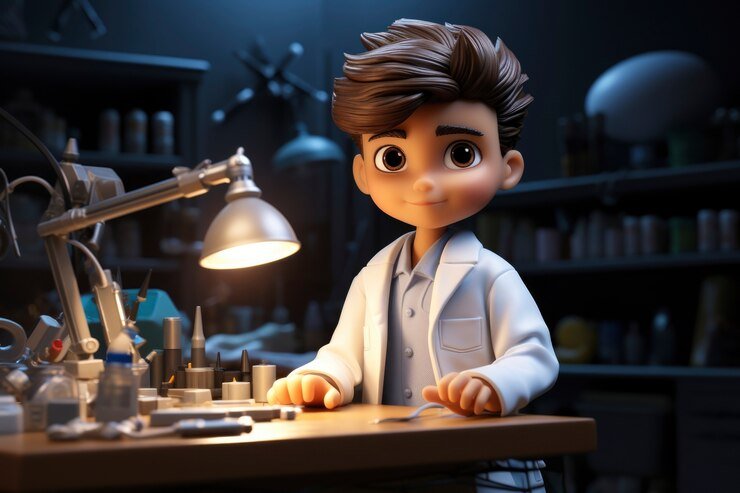How 3D Animation Helps Illustrate Complex Scientific Concepts
In the ever-evolving fields of science and education, the need to communicate intricate ideas in a comprehensible and engaging manner is crucial. This is where 3D animation comes into play, transforming abstract theories and complex phenomena into visual narratives that captivate and educate audiences. Whether used in educational platforms, research presentations, or documentaries, 3D animation plays an essential role in illustrating concepts that are otherwise difficult to understand.
With the help of 3D animation services, scientific concepts such as molecular interactions, astronomical events, or physiological processes can be visualized in detail, making them accessible and engaging for diverse audiences. In this blog, we will explore how 3D animation facilitates the understanding of complex scientific concepts, its applications in various fields, and how it intersects with technologies used in other industries like video games AAA.
The Power of Visualization in Science Education
1. Making the Invisible Visible
Science often involves elements that are invisible to the naked eye, such as molecules, atoms, or microorganisms. These microscopic entities play significant roles in biological and chemical processes, yet they are challenging to visualize using traditional teaching methods. With 3D animation, however, these invisible elements can be brought to life.
- Example: In biology, understanding the complex structure and function of DNA becomes easier when represented through animated sequences. Using 3D animation services, animators can create dynamic models of DNA strands, showing how nucleotides bond and how the double helix forms and unravels during replication or transcription. These animations allow students and researchers to visualize processes that would otherwise be theoretical and difficult to grasp.
2. Breaking Down Complex Processes
Science is filled with processes that are multi-step and complex, involving numerous variables and interactions. Examples include photosynthesis, protein synthesis, and cell division. While these processes are critical to understanding biology and biochemistry, they are often challenging to illustrate with static diagrams or textbooks.
- 3D Animation as a Tool: By using 3D animation services, educators and scientists can create step-by-step visualizations that showcase each stage of a complex process. For instance, an animation on protein synthesis can show how mRNA is transcribed from DNA, how it is translated into a polypeptide chain, and how this chain folds into a functional protein. Such detailed visual explanations make it easier for learners to understand and retain complex information.
3. Demonstrating Large-Scale Phenomena
On the other end of the spectrum, 3D animation is also valuable for illustrating large-scale phenomena such as geological events, astronomical occurrences, or ecosystem interactions. Concepts like plate tectonics, black holes, and climate change can be difficult to represent accurately using 2D graphics alone.
- The Application of 3D Models: Through 3D animation services, scientists and educators can create realistic simulations of these large-scale phenomena. For example, an animation depicting the formation of a black hole can show how massive stars collapse under their own gravity, giving viewers a visual representation of the event. Similarly, animations of climate change can model rising sea levels and atmospheric changes, making the data and predictions easier to understand.
The Role of 3D Animation in Research and Development
1. Visualizing Scientific Data
Research and development (R&D) heavily rely on data, and presenting that data in an engaging and understandable way is essential for conveying findings. Whether in medicine, engineering, or environmental science, data often needs to be visualized to make patterns or trends obvious.
- Converting Data into Visual Narratives: 3D animation services allow scientists to convert complex datasets into animated visuals that make it easier to see trends, outliers, and correlations. In medicine, for example, 3D animations can be used to illustrate how a new drug interacts with cells or tissues. These animations provide clear visual evidence that supports scientific claims, aiding in research presentations and publications.
2. Simulation-Based Research
3D animation technology is also pivotal in creating simulations that test scientific hypotheses and theories. By replicating certain conditions and parameters, scientists can predict outcomes or analyze the behavior of a system under specific scenarios.
- Simulating Physical Phenomena: In physics, for example, simulations of fluid dynamics can model the behavior of liquids and gases under varying temperatures and pressures. These simulations not only provide visual insights into complex phenomena but also allow scientists to modify variables and observe their impact in real time. 3D animation services thus become instrumental in developing simulations that aid in the discovery and validation of scientific knowledge.
Applications of 3D Animation in Different Scientific Fields
1. Medical Animation
One of the most significant applications of 3D animation is in the medical field. Medical animations are used to demonstrate complex surgeries, illustrate how diseases affect the body, and educate patients about their conditions.
- Surgical Procedures: Surgeons often rely on 3D animations to plan complicated operations. These animations provide a detailed, three-dimensional view of human anatomy, helping medical professionals visualize the surgical process before performing it on a patient. For example, animations of heart surgery can illustrate how bypass procedures are performed, improving both doctor training and patient understanding.
- Pharmacology: In pharmacology, 3D animation services create visualizations that show how drugs interact with cells and organs, enhancing the understanding of medication effects at the molecular level.
2. Astronomy and Space Exploration
Astronomy often deals with events and objects far beyond our perception. 3D animation plays a crucial role in simulating astronomical phenomena like solar system formation, planetary orbits, or the lifecycle of stars.
- Space Missions: Organizations like NASA use 3D animation to simulate and visualize space missions. By showing how spacecraft navigate through space and interact with other celestial bodies, these animations help scientists plan missions more effectively. Additionally, these visuals are used in public outreach to educate people about space science.
3. Environmental Science
Environmental science focuses on understanding complex ecosystems and how various factors impact them. Through 3D animation, scientists can illustrate scenarios such as deforestation, species migration, and climate change in a visual and accessible manner.
- Modeling Ecosystems: 3D animations can model the effects of environmental changes on ecosystems. By showing the impact of pollution on marine life or how temperature changes affect vegetation, these animations make it easier for people to grasp the consequences of human activities on nature.
The Intersection of 3D Animation in Science and AAA Video Games
The use of 3D animation in science shares many techniques and technologies with the video game industry, particularly in video games AAA (games developed by major studios with high budgets and advanced technology). The crossover between these fields is increasing, leading to enhanced realism in both scientific simulations and video games.
1. Physics Engines
Both scientific animations and AAA video games use sophisticated physics engines to simulate realistic interactions between objects. In video games, these engines make characters move and react in a lifelike manner, while in scientific animations, they are used to model phenomena like fluid dynamics, gravitational forces, and collision events.
- Cross-Disciplinary Techniques: Scientists and animators collaborate to use these engines for creating accurate simulations, whether it’s the flow of air over an airplane wing or the movement of tectonic plates. The shared use of these technologies not only advances video game realism but also enhances the accuracy of scientific visualizations.
2. Rendering Techniques and Real-Time Animation
The realistic rendering techniques developed for AAA video games are also applied in scientific animation to create hyper-realistic visuals. For example, the rendering of human organs, astronomical bodies, or chemical reactions in science animations benefits from the same techniques used to create lifelike characters and environments in games.
- Virtual Reality (VR) and Augmented Reality (AR): Both fields also explore VR and AR technology. Scientists use VR and AR to immerse users in simulated environments, allowing them to interact with and observe complex scientific processes from various angles. Similarly, video games AAA utilize these technologies for immersive gaming experiences. The convergence of these fields shows how developments in one area can lead to advancements in the other.
Conclusion
3D animation has revolutionized the way scientific concepts are communicated, making abstract and complex ideas accessible to diverse audiences. From visualizing invisible microscopic processes to simulating large-scale phenomena, 3D animation services provide an invaluable tool for scientists, educators, and researchers. By leveraging the same technologies used in video games AAA, scientific animations achieve unprecedented levels of realism and interactivity, enhancing both understanding and engagement.
As technology continues to evolve, the intersection between scientific visualization and video game technology will likely deepen, opening up new avenues for education, research, and entertainment.





